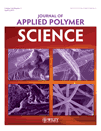Physico-mechanical properties of natural rubber sheets coated by polyethyleneimine-functionalized poly(methyl methacrylate) nanoparticles
Abstract
The surface modification of sulfur-prevulcanized natural rubber (SPNR) sheets by the polyethyleneimine-functionalized-poly(methyl methacrylate) (PMMA/PEI) nanoparticles was successfully performed via a simple dipping method. The percentage of surface coverage (Cs) of the nanoparticles on SPNR sheets was found to be affected by a variation of nanoparticle latex concentrations and immersion times. The adsorption isotherm of PMMA/PEI nanoparticles on SPNR sheets was analyzed and found to fit well to the Freundlich model. After coating, it can be observed that the presence of PMMA/PEI nanoparticles on SPNR surface had no effects over the SPNR mechanical properties e.g., tensile strength, elongation at break, and hardness. On the other hand, the coated SPNR sheets showed a reduction of surface friction coefficients and interfacial adhesion up to 45 and 59%, respectively. Furthermore, PMMA/PEI nanoparticles adsorbed on the SPNR surface was subjected to stretching and wearing conditions, and found to be stable for at least seven stretching and wearing cycles. © 2011 Wiley Periodicals, Inc. J Appl Polym Sci, 2012




